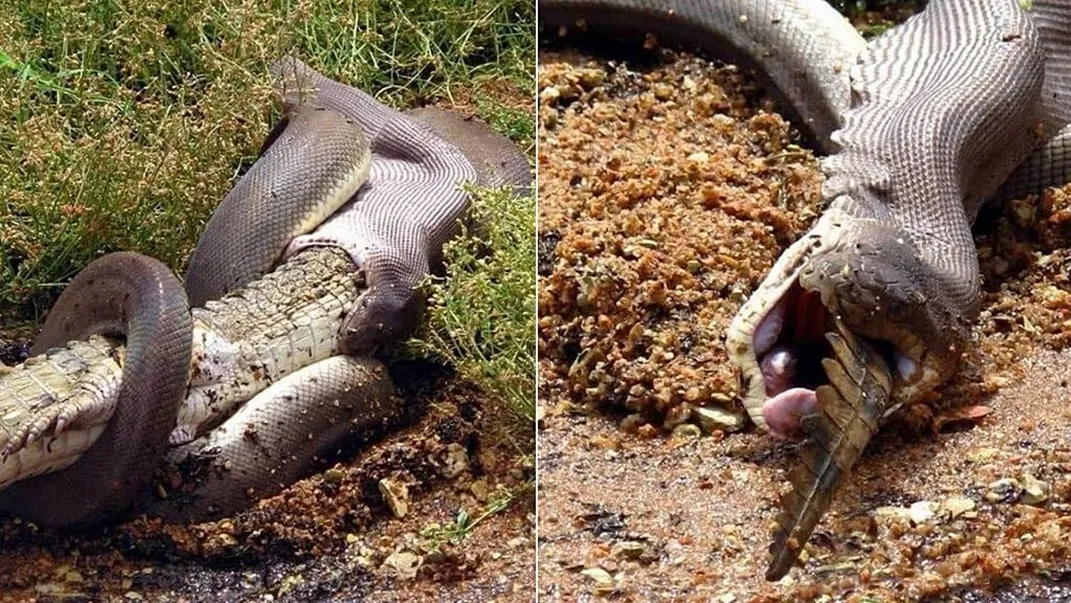See a Python Swallow a Crocodile Whole
A kayaker captured the gruesome photographs while exploring a swamp in Queensland, Australia
/https://tf-cmsv2-smithsonianmag-media.s3.amazonaws.com/filer/b2/4f/b24f7eea-e90b-47b6-99e8-f9ba048869f6/olive-python-crocodile_03_2019-07-05.jpg)
During a recent trip to Queensland’s Mount Isa, kayaker Martin Muller encountered a gruesome sight: an olive python feasting on an Australian freshwater crocodile it had just squeezed to death. Naturally, Muller pulled out his camera and started snapping.
The photographs, posted on Facebook by Australian nonprofit GG Wildlife Rescue Inc., show the snake wrapping its body around the hapless croc, opening its elastic jaws and swallowing its prey whole. In several shots, the crocodile appears to have completely disappeared down the python’s gullet, but upon closer inspection, viewers can discern the end of the animal’s spiked tail peeking out of the snake’s mouth. Other unsettling scenes include images of the engorged python, its body stretched to accommodate the crocodile’s body, post-mealtime.
As Live Science’s Stephanie Pappas reports, pythons aren’t exactly known for their discriminating palate. As ambitious predators, the snakes have been known to dine on prey as varied as deer, impalas, porcupines, pigeons, goats, other pythons and even humans.
“It's common for them to eat pretty much anything if they can fit it in their mouth,” GG Wildlife Rescue Inc.’s owner, Michelle Jones, tells the Daily Mail Australia.
Crocodiles and alligators actually end up on pythons’ plates with relative frequency: In 2005, a deceased Burmese python was found in the Florida Everglades with an American alligator bursting out of its stomach, and in 2014, an olive python—the same species photographed by Muller—was caught on camera killing and eating a freshwater crocodile at a lake near Mount Isa. The entire process reportedly took around five hours.

According to New York Daily News’ Shannon Mason, olive pythons regularly clash with freshwater crocodiles. The native-Australian snakes average around 13 feet long. (Some pythons can grow up to 20 feet long or more.) However, the crocs, which are “small for their genus,” average around six to nine feet long and can reach up to 13 feet long.
Contrary to popular belief, pythons don’t detach their jaws in order to swallow enormous victims. Instead, Corey Binns writes in a separate Live Science article, snakes utilize two lower jaws that move independently of each other but are connected by an elastic ligament. Once a python has its stretched jaws grasped around a target, it compresses its muscles to simultaneously constrict and engulf prey. Per the Herpetological Society of Ireland’s J.P. Dunbar, the set of movements used to send a victim down a python’s throat is known as the “pterygoid walk”; essentially, the snake simply “walks its head over its meal.”
The final step in the python’s feast is digestion. As Live Science’s Pappas writes, the animals are known to alter their metabolism after eating, increasing the size of internal organs including the intestines, heart and pancreas in order to manage the influx of calories. Although snakes digest all of their victims’ bones, flesh and organs, they tend to excrete keratin- and enamel-rich body parts such as scales and teeth.
/https://tf-cmsv2-smithsonianmag-media.s3.amazonaws.com/accounts/headshot/mellon.png)
/https://tf-cmsv2-smithsonianmag-media.s3.amazonaws.com/accounts/headshot/mellon.png)